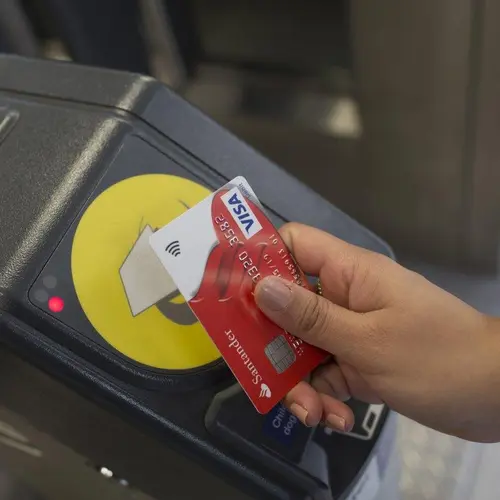The end of the MetroCard could mean fare capping, better bus boarding, and real-time data

Image via Cubic Transportation Systems
The MTA’s new cardless fare system will completely phase out the MetroCard by 2023, and transit advocates from the TransitCenter and the Tri-State Transportation Campaign believe there’s more to gain here than strictly streamlining the swiping process. In a report released this week titled “A New Way to Ride,” the groups outline three main policy opportunities available through the new fare system–seamless bus boarding, fare capping, and enhanced service information–all of which have been implemented in other cities with similar payment technology.

Today, the advocates submitted their report, along with a letter, to the MTA, reports the Wall Street Journal. “We are afraid that if we don’t even call for basic things, that given the experience of the MetroCard they’re not going to do it,” said the TransitCenter’s Colin Wright.
In October, the MTA awarded a $540 million contract to San Diego-based company Cubic Transportation Systems, who will “handle the design, integration, supply, and implementation of the fare system,” which is being modeled on the one used in London’s Underground and commuter railroads. The digital readers will accept payment via credit card, mobile phone, smartwatch, or a special contactless card. It will accept these payments at subways, buses, the LIRR, and Metro-North, eliminating the need for multiple fare passes. Plus, it will have the capability for personalized transit accounts where riders can check things such as ride history and balances.
To further enhance the transit experience, the report is calling for the following three initiatives:
1. Better Bus Boarding
 A select bus stop, via MTA Flickr/Patrick Cashin
A select bus stop, via MTA Flickr/Patrick Cashin
Many “select,” or express, bus routes currently offer all-door boarding and curbside payment machines, the implementation of which has cut journey times by up to 30 percent. Further, it’s cut fare evasion between 50 and 80 percent. And for a city whose buses run at the slowest pace in the country and who has lost 100 million passengers since 2008, it’s especially important to roll this system out system-wide.
Oslo and San Francisco, both of which have modern fare payment technology, have been using all-door boarding since 2008 and 2012 respectively. MTA spokesman Jon Weinstein says it’s “a concept we’re very supportive of.” The report would like to see it rolled out along with the new fare system, by 2018, including smaller and easier-to-use curbside payment machines.
2. Fare Capping

Image by Ged Carroll/Flickr
Back in November, transit advocates spoke out in favor of fare capping, a policy where “riders pay per ride until the daily or weekly capping rates are reached, with every ride being free after that.” The idea is to make the system more equitable. As the groups explain in their letter, “Riders who can afford a monthly pass benefit from significant per-ride discounts. Lower-income riders with less cash on hand often pay the costlier per-ride fare.” But because the new fare payment system will have the capability to count how many times a rider swipes within a given time span, fare capping can be employed just as it has been in London since 2005 (where it was put in place by Cubic).
3. Enhanced Service Information
 Image via Roman Kruglov/Flickr
Image via Roman Kruglov/Flickr
Accurate, real-time service and station information should be a no-brainer, but it’s an area in which NYC is severely lacking. The MTA currently has several different mobile applications for subways, buses, LIRR, and Metro-North, but by creating a systemwide platform, riders will be better able to see all their options based on wait times, service disruptions, station closures, and elevator and escalator outages. To do this, the report says “Real-time transit data, including GPS-enabled vehicle location information, passenger count, and fare collection data, and service-disruption information must be continuously refined and made reliable.” However, it also notes that this “requires a commitment from various MTA departments to closely coordinate and faithfully share data to the public and with third-party trip-planning apps like Google Maps.”
—
The new fare readers began a testing phase in October. They’ll be officially rolled out at select subway and bus stations in May 2019 with the goal of having the entire system built out by 2020. The MetroCard will remain as an option during the transition but will be completely out of use by 2023.





























